
In October of last year, I had the good fortune to visit the Asa Wright Nature Center and Tobago through Caligo Birding Tours. Trinidad and Tabago are blessed with abundant hummingbirds on both Islands, both at Asa Wright on Trinidad and at the home of Newton George on Tabago. Sometimes there are places with many hummingbirds of just one or two species, but my experience on both islands was both large numbers and a good selection of species, depending to some extent on the time of year that I visited. One of the largest and most beautiful hummingbirds that can be reliably found on both islands in all seasons is the White Necked Jacobin. While I have seen them in smaller numbers in Costa Rica, both sexes were nicely represented at Asa Wright. One of the downsides of having a fair number of both hummingbird numbers and species is the problem of “the little green hummingbird”. By this I mean, small green hummingbirds that look very similar, which usually but not always, can be identified by their limited range and/or your location. In some unfortunate locations which include Trinidad and Tobago, there are several small green hummingbirds that look similar, all in the same place. While this creates some difficulties, close observation can usually resolve ambiguities. I have included both flash and natural photographs and the ISO since I believe flash photography reveals additional aspects of hummingbird colors.
White-Necked Jacobin



The White-Necked Jacobin (Florisuga mellivora) is a large and majestic hummingbird with its white belly and tail, a white band on the nape and a dark blue hood, that ranges from Mexico, south to Peru, Bolivia and south Brazil. I personally find the White-Necked Jacobin to be one of the most beautiful hummingbirds and you can see how the colors change with and without flash. The younger males are shorter with a wider tail with brown tipped white feathers on the bottom of the tail. Immature males also have a conspicuous rufous patch on the face not shown here.


Mainly on the island of Tobago, there is a different subspecies of White-Necked Jacobin, who are longer and more slender than the many others on the mainland. This unusual subspecies was first described by Gould in 1846. Apparently there are also some birds from the Santa Marta mountains in NE Colombia that are also large although they may have different characteristics than the ones from Tobago. Sometimes the name tobagensis is used as a synonym of flabellifera. So two subspecies are recognized, the original described by Linnaeus in 1758, Florisuga mellivora mellivora, and this one larger subspecies from Tobago, Florisuga mellivora flabellifera.



Female White-Necked Jacobins are highly variable, and may resemble adult or immature males, have green upperparts, white belly, white-scaled green or blue throat, and white-scaled dark blue crissum (the area around the cloaca). Female identification can be potentially confusing, but the pattern on the crissum is distinctive and not shared by superficially similar species, although good luck getting a good view like the one above.

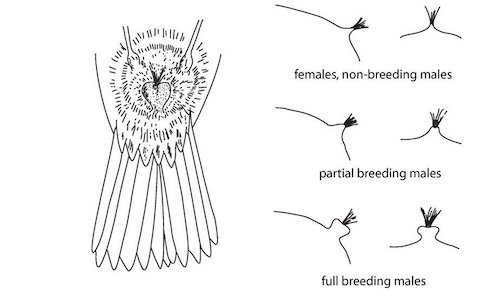
The cloaca is the single posterior opening for a bird’s digestive, urinary, and reproductive tracts and is used to expel feces and lay eggs. The cloaca is found on the rear of the body under the base of the tail, covered by feathers on the extreme lower abdomen. Those feathers surrounding the cloaca are called the crissum or undertail coverts. The cloaca and the area of the body where it is located, as well as the physical slit opening itself, is also frequently called the vent. During mating, the male perches on top of the female, who moves her tail feathers to the side to expose her cloaca. Arching back, the male rubs his cloaca against hers. During the breeding season, the cloacal area swells and the tissues protrude slightly outside the body to make breeding easier. Male birds show more swelling, and bird banders will gently blow on a bird’s vent to expose the cloaca and examine its size to determine a bird’s gender.
Tufted Coquette

The Tufted Coquette (Lophornis ornatus) is a tiny and adorable hummingbird that breeds in eastern Venezuela, Trinidad, Guiana, and northern Brazil. It is an uncommon but widespread species, and appears to be a local or seasonal migrant, although its movements are not well understood. This small bird inhabits open country, gardens, and cultivation. There was at least one pair at Asa Wright.
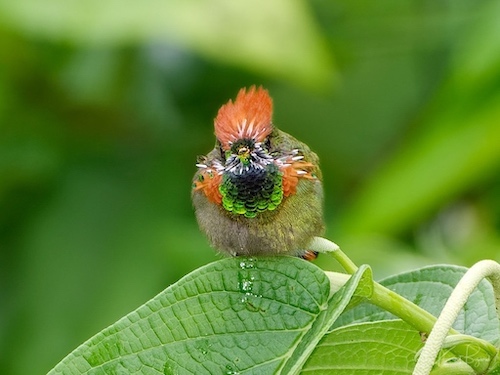
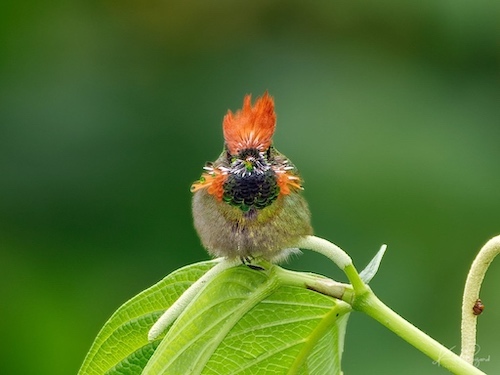

The value of flash photography is well illustrated in these photographs. Without a flash it is unlikely that I would have been able to capture the illuminated green gorget on this male bird. For such a small bird there is a spectacular amount of detail and showy green sparkles to be seen.

The tufted coquette is 6.6 centimetres (2.6 in) long and weighs 2.3 grams (0.081 oz). The black-tipped red bill is short and straight. The male has a rufous head crest and a coppery green back with a whitish rump band that is prominent in flight. The forehead and underparts are green, and black-spotted rufous plumes project from the neck sides. The tail is golden rufous. The female lacks the crest and plumes. She has green upperparts (dorsal), except for the whitish tail band, and rufous underparts (ventral) that become much paler on the belly. The tail is mostly bronze green with a dusky band and whitish tips to the feathers. Immature males resemble the female, but their throats are whitish with fine dark spotting.


I was privileged to be able to observe the mating ritual between a male and female Tufted Coquette over a period of about 45 minutes. I must have gotten 30 photos of precision flying by these two lovebirds, first darting away, then coming back together, all through the branches of a large Porterweed bush. Afterwords it occurred to me that I should have tried to get video but these hummingbirds are so small and their movements so quick that I am not certain that I could have realistically gotten usable video. In any case this encounter was one of the most breathtaking experiences I have had in my time as a nature photographer.
White-Chested Emerald
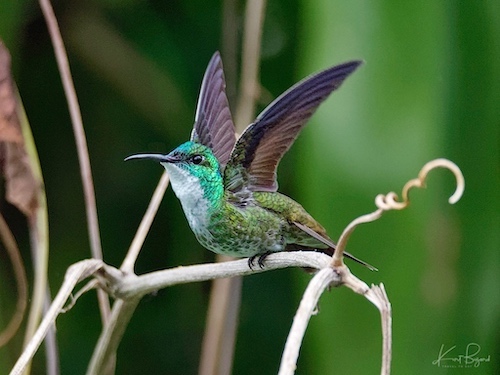
The White-Chested Emerald is a widespread and common species in Trinidad, less so in Venezuela. It appears to be a local or seasonal migrant, although its movements are not well understood. It is a bird of cultivation, woodland and forest. The female lays her eggs in a small cup nest made of plant fiber and placed on a horizontal tree branch. At Asa Wright these hummingbirds are common, daring and unafraid. They frequents the upper hummingbird feeders, hung from the upper deck. White-chested emeralds feed on nectar, usually taken from the flowers of large trees, but sometimes from smaller plants such as Heliconia. They also take small insects. The song of this species is a churring tche-tche-tche-tche-tche.

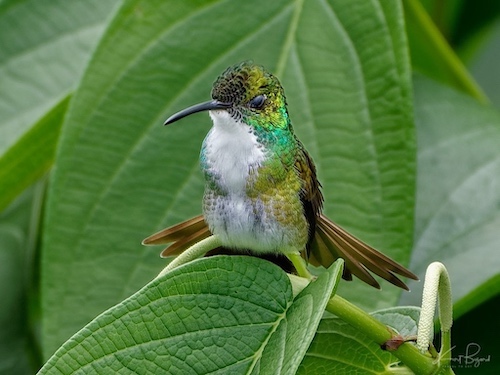


They are identified by their mostly white underparts and reddish-copper upper tail. Morphometric measurements reveal that the subspecies found in Trinidad is actually larger than those found on the South American mainland. The white-chested emerald is approximately 9 cm long and weighs 4.7 g. The black bill is straight and fairly long, at nearly 2 cm. It has bright golden-green upperparts, becoming bronze on the tail, white underparts, and its flanks are green, or white spotted with green. The tail is tipped with purple-black. The sexes are similar.


The white-chested emerald (Amazilia brevirostris) is a hummingbird found in eastern Venezuela, the Guianas, Trinidad and far northern Brazil (Roraima). I believe the two photos shown just above demonstrate White-Chested Emeralds from the mainland since they appear to be much smaller than the typical ones shown farther up from Trinidad. The genus Amazila is a diverse collection of hummingbirds who are occasionally placed in the genera Agyrtria, Polyerata and Saucerottia. This is the genus that many of the little green hummingbirds, mentioned at the top of the post, are sometimes placed. But most authorities, notably the SACC, do not accept the validity of these until more comprehensive studies are available.
Copper-Rumped Hummingbird

The Copper-Rumped Hummingbird (Amazilia tobaci) sometimes placed in the genus Saucerottia, is a small bird that breeds in Venezuela, Trinidad and Tobago, and has occurred as a vagrant on Grenada. It is a seasonal migrant in parts of Venezuela. It is the most common hummingbird in Trinidad and Tabago.




The copper-rumped hummingbird is 8.6 cm long and weighs 4.7 g. The bill is fairly long, straight and mostly black with some pink on the lower mandible. The adult has copper-green upperparts, becoming copper-bronze on the rump. The head and underparts are bright green, the thighs are white and the tail and legs are black. The sexes are similar.



The subspecies which breeds in Trinidad, Amazilia tobaci erythronota, is smaller and has more bronzing on the upperparts than the nominate Amazilia tobaci tobaci of Tobago. The latter race has occurred as a vagrant to Grenada. There are several other subspecies in Venezuela differing mainly size and in the colour of the rump and back. Like other members of the genus Amazili, this hummingbird is variable in appearance depending on location and will probably end up being in a different genus and/or being split up when studies are complete.
Blue-Chinned Sapphire


The Blue-Chinned Sapphire (Chlorestes notata) is a hummingbird that breeds from Colombia south and east to the Guianas, Trinidad, Peru, and Brazil. There have been occasional records from Tobago. For Brazil, the species’ range is along the main Amazon River Basin, as well as the Atlantic Forest, both in the northeast, as well as far south on the southeast coastal strip, (an entire coastal strip, north-east-south of about 3000 km). It is sometimes placed in the genus Chlorostilbon.
Blue-Tailed Emerald



The blue-tailed emerald (Chlorostilbon mellisugus) is a hummingbird found in tropical and subtropical South America east of the Andes from Colombia east to the Guianas and Trinidad, and south to northern Bolivia and central Brazil. The blue-tailed emerald is 7.5 cm (3 in) long and weighs 2.6 g. The black bill is relatively short and straight. The male has a brilliant green plumage, with white thighs and a dark metallic blue tail (clearly forked in the northern part of its range; slightly so in the central and southern part). This hummingbird has numerous subspecies with a fair amount of variation among the subspecies. It is a bird of savanna, scrub, cultivation and similar semi-open woodland. Blue-tailed emeralds feed on insects and nectar. The song is a pleasant twittering, and the call of this species is a pebbly tsip.
White-Tailed Sabrewing


The White-Tailed Sabrewing (Campylopterus ensipennis) is a large hummingbird that breeds in northeastern Venezuela and Tobago. It was thought to have become extinct in Trinidad and Tobago after Hurricane Flora in 1963, but the population has now largely recovered. This species is now featured on Tobago’s environmental posters under the nickname “Campy”. These two photos were taken in the tropical forest of the Tobago Main Ridge Forest Preserve.


The Sabrewings are very large compared to other hummingbirds. The White-tailed Sabrewing measures between 4.7 – 5.5 inches (12 – 14 cm) in length and weigh about 0.4 oz or 10 g. The adult male is bright green with a shiny blue throat. The female has a smaller blue bib or gorget with an irregular white malar line or stripe. The malar stripe is a mustache-like marking on a bird’s face that extends from the base of the bill to the side of the neck, usually in a downwards and backwards direction. In addition, instead of a uniform green color as seen in the male, the chest and belly are gray/tan with multiple round green/blue spots as seen above. Both sexes have a white spot behind the eye and white outer tail feathers. Adult males have widened ‘sabres’ (shafts of outermost primary flight feathers) that are acquired during the second year.



The food of this species is nectar, taken mainly from undergrowth flowers. Male white-tailed sabrewing perch conspicuously and defend their territories aggressively against other hummingbirds. This large species is fearless and inquisitive. The call is a rolled chinzink.
Brown Violetear

The Brown Violetear (Colibri delphinae) is a large and beautiful hummingbird that breeds at middle elevations in the mountains in Central America, and western and northern South America (primarily the Andes and the tepuis) with isolated populations on Trinidad and in the Brazilian state Bahia. The breeding habitat is forest at altitudes between 400–1600 m, but the brown Violet-Ear will spread widely into the lowlands when not nesting. It is replaced at higher altitudes by its relative, the Lesser Violetear (Colibri cyanotus), but their ranges overlap widely.

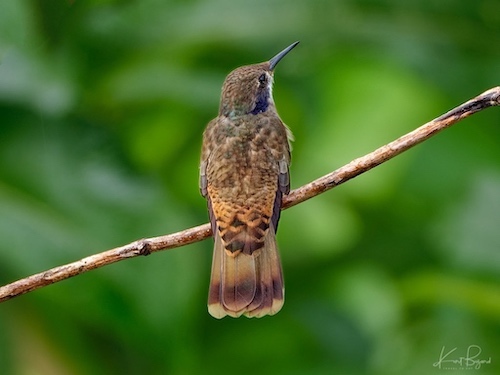

The 11.5 cm long, 6.5–7 g weight brown violetear is unmistakable; it is mainly dull brown, with a rufous rump and greyer underparts. There is a violet patch running back and down from the eye, a hermit-like malar stripe, and a glittering green and blue throat stripe. The bill is relatively short and almost straight. The female is similar to the male, but has a smaller throat patch. Immature bird have rufous fringes to the upperpart plumage, and little or no violet behind the eyes.


The brown violetear feeds on nectar from small flowers of trees and epiphytes. It also takes insects, often caught in flight (hawking), as an essential source of protein. Although not particularly territorial, this species is highly aggressive, and at feeders seems to spend far more time attacking other hummingbirds than actually feeding. They favor flowers with the highest sugar content (often red-colored and tubular-shaped) and seek out, and aggressively protect, those areas containing flowers with high energy nectar. Many native and cultivated plants on whose flowers these birds feed heavily rely on them for pollination. The mostly tubular-shaped flowers actually exclude most bees and butterflies from feeding on them and, subsequently, from pollinating the plants.
Green Hermit

The Green Hermit (Phaethornis guy) is a large hummingbird that is a resident breeder from southern Central America (Costa Rica and Panama) south to northern South America (north-eastern Venezuela and Trinidad, and the northern Andes of eastern Peru).





It is 5.3 inches (13.5 cm) long and weighs 0.22 oz (6.3 g). The male is mainly dark green with a blue-green rump. It has a dark mask through the eye, with buff stripes above and below this, and down the center of the throat. The female has a thinner mask over the eyes, also with with buff stripes above and below, and down the center of the throat. The central feathers of the tapered tail are, for a large hermit, relatively short and white-tipped, and are wiggled in display at the communal leks. A lek is an aggregation of male animals gathered to engage in competitive displays, lekking, to entice visiting females which are surveying prospective partners to mate with. The reddish bill is long and decurved. The female is sooty gray (rather than green) below, with an even longer bill and a much longer tail. The call of this species is a loud zurk, and the males’ lekking “song” is a repeated swark. There are currently four described subspecies of the Green Hermit. The nominate subspecies Phaethornis guy guy is found in Venezuela and Trinidad.
Rufous-Breasted Hermit

The Rufous-Breasted Hermit or Hairy Hermit (Glaucis hirsutus) is a hummingbird that breeds from Panama south to Bolivia, and on Trinidad, Tobago and Grenada. It is a widespread and generally common species, though local populations may change in numbers and disappear altogether in marginal habitat.

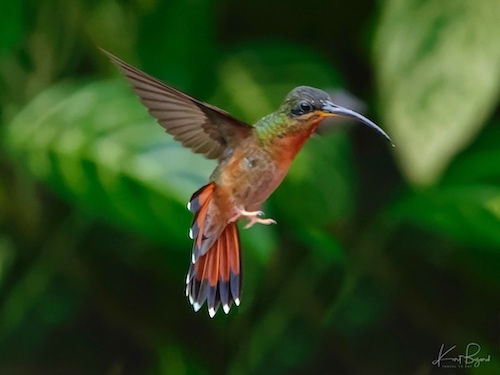
It is 4.2 inches (10.7 cm) long and weighs 0.25 oz (7 gm) on average. The bill measures around 3.3 cm (1.3 in) and is strongly decurved, long and thin, though compared to the bills of other hummingbirds, it is rather robust. The rufous-breasted hermit has a brownish head, bronze-green upperparts and rufous underparts. The tail has green central feathers and rufous outer feathers, all tipped white. The bill has a yellow lower mandible and a black upper mandible. Sexes are similar, but the male has yellow streaking on the upper mandible, and the female may be slightly duller in plumage. The bill of females is also proportionally a bit shorter (though this is hardly recognizable) and more decurved (which is quite conspicuous in direct comparison).


Glaucis hirsuta has very discriminating feeding habits. It will only visit flowers whose length and curvature precisely matches that of its bill, while most other hummingbirds are far more flexible. Thus, its foodplants are found across almost the entire diversity of angiosperms. Very popular with this bird are Zingiberales, such as Costus scaber (Costaceae), or Heliconia standleyi and Heliconia stricta (Heliconiaceae). This is typical of all Hermit hummingbirds since their long curved beak was a co-evolutionary process shared with Heliconia in particular and other members of the Zingiberales which I have discussed in previous posts.

As always, I hope you enjoyed the post, the hummingbirds in Trinidad and Tobago are diverse and beautiful.
References:
10 Day 2 Island Classic Birding Tour
Asa Wright White-Necked Jacobin

